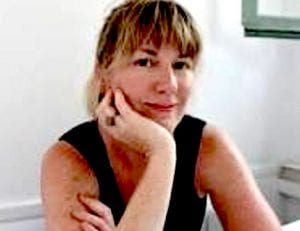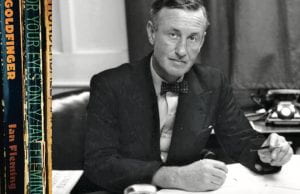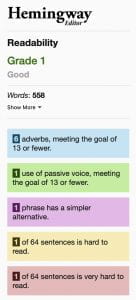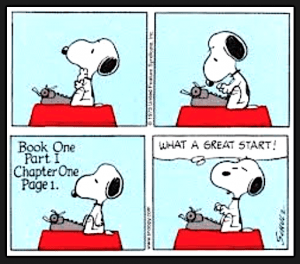 Maggie Shipstead (left) writes, “John Gardner famously wrote that fiction should be a “vivid, continuous dream,” but some readers’ willingness to dream is more robust than others. Some people will shut a book forever at the first sign of an error, their trust in the writer and their suspension of disbelief irrevocably lost. Others will happily read along through almost anything, swallowing the most preposterous plot points, the most egregious anachronisms, and the most glaring inconsistencies…But I think sloppiness is worth trying to avoid, both out of pure principle (why get something wrong when you could get it right?) and because mistakes can be indicative of an author not pressing hard enough on the world she’s building, not making it sturdy enough, settling for a facade.” In her article, Maggie mentions good, or ill-meaning, folks who delighted in pointing out errors in her published work. I had a textbook that was in its 3rd reprint when along came a young student (aka smarty pants) who wrote to my publisher to point out an error, and it was an obvious one—one that escaped the keen eye of editor, writer, proof-reader, etc. How could this happen? In my first novel, the errors kept creeping out of the pages; proof that I was a lousy writer? No matter how hard I tried, the errors were there and my flame-thrower spell checker never seemed to pick them up. When all seemed well, my American spelling lapsed into English spelling; a tense changed within a paragraph, etc. Why all these mistakes? Because, writers, like other humans, are fallible. We get tired. We get over our draft revisions and we long to be rid of the manuscript. My advice to those who find errors? Tell us, but then hide under the bed-covers before we find you and hit you over the head with our revised edition :-).
Maggie Shipstead (left) writes, “John Gardner famously wrote that fiction should be a “vivid, continuous dream,” but some readers’ willingness to dream is more robust than others. Some people will shut a book forever at the first sign of an error, their trust in the writer and their suspension of disbelief irrevocably lost. Others will happily read along through almost anything, swallowing the most preposterous plot points, the most egregious anachronisms, and the most glaring inconsistencies…But I think sloppiness is worth trying to avoid, both out of pure principle (why get something wrong when you could get it right?) and because mistakes can be indicative of an author not pressing hard enough on the world she’s building, not making it sturdy enough, settling for a facade.” In her article, Maggie mentions good, or ill-meaning, folks who delighted in pointing out errors in her published work. I had a textbook that was in its 3rd reprint when along came a young student (aka smarty pants) who wrote to my publisher to point out an error, and it was an obvious one—one that escaped the keen eye of editor, writer, proof-reader, etc. How could this happen? In my first novel, the errors kept creeping out of the pages; proof that I was a lousy writer? No matter how hard I tried, the errors were there and my flame-thrower spell checker never seemed to pick them up. When all seemed well, my American spelling lapsed into English spelling; a tense changed within a paragraph, etc. Why all these mistakes? Because, writers, like other humans, are fallible. We get tired. We get over our draft revisions and we long to be rid of the manuscript. My advice to those who find errors? Tell us, but then hide under the bed-covers before we find you and hit you over the head with our revised edition :-).
James Hayden
Author or Writer?
 “I have a charming relative who is an angry young littérateur of renown. He is maddened by the fact that more people read my books than his. Not long ago we had semi-friendly words on the subject and I tried to cool his boiling ego by saying that his artistic purpose was far, far higher than mine. He was engaged in “The Shakespeare Stakes.” The target of his books was the head and, to some extent at least, the heart. The target of my books, I said, lay somewhere between the solar plexus and, well, the upper thigh. These self-deprecatory remarks did nothing to mollify him and finally, with some impatience and perhaps with something of an ironical glint in my eye, I asked him how he described himself on his passport. “I bet you call yourself an Author,” I said. He agreed, with a shade of reluctance, perhaps because he scented sarcasm on the way. “Just so,” I said. “Well, I describe myself as a Writer. There are authors and artists, and then again there are writers and painters.”
“I have a charming relative who is an angry young littérateur of renown. He is maddened by the fact that more people read my books than his. Not long ago we had semi-friendly words on the subject and I tried to cool his boiling ego by saying that his artistic purpose was far, far higher than mine. He was engaged in “The Shakespeare Stakes.” The target of his books was the head and, to some extent at least, the heart. The target of my books, I said, lay somewhere between the solar plexus and, well, the upper thigh. These self-deprecatory remarks did nothing to mollify him and finally, with some impatience and perhaps with something of an ironical glint in my eye, I asked him how he described himself on his passport. “I bet you call yourself an Author,” I said. He agreed, with a shade of reluctance, perhaps because he scented sarcasm on the way. “Just so,” I said. “Well, I describe myself as a Writer. There are authors and artists, and then again there are writers and painters.”
This rather spiteful jibe, which forced him, most unwillingly, into the ranks of the Establishment, whilst stealing for myself the halo of a simple craftsman of the people, made the angry young man angrier than ever and I don’t now see him as often as I used to. But the point I wish to make is that if you decide to become a professional writer, you must, broadly speaking, decide whether you wish to write for fame, for pleasure or for money. I write, unashamedly, for pleasure and money.” by Ian Fleming
5 Key Elements for a Thriller
While hosting workshops in the USA I found that the most popular ones were those with a catchy title, such as “10 Top Tips for Technology Teachers.” Hence the title for this post. Catchy, huh? Well, almost. The danger is that my top 5 tips might not be your ones. The following are from an article in masterclass.com and I will personalise a few to give my perspective. Let’s get into this:
- Make your main character compelling. In the thriller genre—just like in real life—a conflict is rarely as simple as “good guy vs. bad guy.” Good thrillers often feature protagonists that are flawed and complex…Readers relate to imperfect heroes, and having a main character with flaws will increase the tension and stakes of your story. Having a deep, three-dimensional main character is an essential ingredient of a successful thriller. [I totally agree. Of most importance is to allow the flaws in your main character to enable them to change/flip 180 degrees/grow into the villas. Mine did this by mistake. He started out as an ageing spy, but…oops, can’t give it away that easily!] Can you find the main character here below? Yes, of course you can, but is he/she compelling enough to stand out among the others?
 More about character flaws can be found here.
More about character flaws can be found here.

- The opening scene has plenty of action. Readers MUST be on the edge of their seats from the very first page. The opening scene of a thriller novel should introduce the crime, conflict, or stakes as quickly as possible. The best thrillers hook their readers with instant action, then fill in the necessary character and storyline information later. [Comment: avoid fluff at the start. Action, action, action. Some suggest that a thriller should start at the point of most conflict, then unpack it in the following chapters.]
- Create an interesting villain. Even your antagonist is unforgivable, their motivations should be rooted in a relatable desire or emotion. In other words, they should be motivated by their own twisted, internal logic (e.g. The Silence of the Lambs its subsequent sequels, readers learn through flashbacks that Dr. Hannibal Lecter witnessed the murder of his sister when he was young. Therefore, Dr. Lecter is more than just a psychopathic serial killer—he is a person whose evil actions stem from a heartbreaking trauma). Readers are more likely to be engaged in your villain’s story and character development if they can recognize seeds of themselves in your antagonist.
- Build obstacles for your protagonist. If there’s one thing that all bestselling authors of thrillers are good at, it’s putting their protagonist in harm’s way. Your main character should experience heartbreak, trauma, and anxiety throughout the book. Sometimes, the most effective obstacle is a ticking clock or strict time limit to complete their task. Obstacles will also increase the narrative satisfaction of the end of the book, when your protagonist finally overcomes the hurdles and triumphs over adversity. [Yes, have a chase that is race against time.]
- Add plenty of plot twists and turning points. More so than any other genre, thriller novel writing requires the story to contain an abundance of plot twists, turning points, and cliffhangers. If you’re experiencing writer’s block when writing a scene, ask yourself what a reader might expect to happen next. How can you subvert those expectations? If a scene feels uneventful, think about what plot element or character you can introduce to raise the stakes or create a dilemma for your protagonist. Plot twists will ensure that your thriller is a page-turner and make it impossible for your reader to put it down. [Right on! In my last thriller I was writing a new chapter when it suddenly took a turn that I never expected.]
Plans for the day?
It’s a common question – “What are your plans for the day?” A social greeting question, and one that we almost expect. It’s the question I get asked when I sit to have my hair cut, or while talking with my children. And, it’s an ideal question to drop into casual conversation in a thriller; a sure way to put the reader at ease, before winding up the tension with an unexpected reply. Here’s what I mean when I write that innocuous question into my new thriller;
—
The black BMW limo glides west onto the B44, then loops back to follow the Theodor-Stern-Kai motorway, parallel to the River Main. As they slow for the Friedensbrücke bridge the driver glances in his mirror.
“Sir, if I may ask, what have you got planned for the day?”
Michael is silent, his thoughts caught by dazzling sunlight on the water. Across the bridge, he gazes at the rising commercial landscape north of the round Westhafen Tower and finally speaks as their destination comes into view.
“I plan to change the world.” [new thriller, Ch 2]
—
Closer to the Gates of Hell
We had a friend staying with us recently who told us about his fear of driving through a car wash. He had a bad childhood experience which surfaces when he has to lock the car doors and look out at the swishing of water and rollers. In my new thriller, the crew of a submarine face their greatest fear—the fear of breaking up at depth; a depth that is a secret known only to a few. If you ask a submarine captain how deep they can go, the answer is always “deep enough.” If you ask the engineers who designed it, they will say “a little deeper than the specs.” Can you imagine the horror of being in a steel tube that implodes underwater; the sudden implosion that ends life in an instant. Worse is the gradual squeezing of a hull under pressure; a tightrope of fear that envelops sailors and drags them closer to the gates of hell.
“A jolt shot through the hull, pinging like a hammer on steel. The sailors jumped. Some crossed themselves, while others kissed their crosses. Every hand on its controls was a fist of white knuckles, clinging to their fears. Each foot deeper brought them closer to the gates of eternity. The hull had to give. One false move and it would be over, and Hammerhead would join the long list of subs lost at sea with all hands.” [new thriller, pg 99]

Big Brother
My new thriller leans upon a short video presented by Apple when they launched the MacIntosh computer. The concept is far from new, but dramatic in presenting Big Brother in black and white, then shattering the conformity when an athlete hurls a hammer into the screen. Let’s take a minute to view this:
Big Brother is a fictional character and symbol in George Orwell‘s dystopian 1949 novel Nineteen Eighty-Four. He is ostensibly the leader of Oceania, a totalitarian state wherein the ruling party, Ingsoc, wields total power “for its own sake” over the inhabitants. In the society that Orwell describes, every citizen is under constant surveillance by the authorities. In modern culture, the term “Big Brother” has entered the lexicon as a synonym for abuse of government power, particularly in respect to civil liberties, often specifically related to mass surveillance. (source: Wikipedia). In my new novel, a group of talented underwater experts plan to turn the tide on a contemporary Big Brother through the most audacious heist ever.
Editing 101
This may, or may not, help budding writers: What is the best way to edit your manuscript? Here’s my take, based on the experience of two novels:
Step 1: Finish your Manuscript, then throw it aside for a few weeks. Return to it and read it through, noting obvious errors. Each time you step away from your manuscript you come back to it from a fresh perspective. Note: your first draft is always (yes, always) inadequate.
Step 2: Use an Online Editor. I like using prowritingaid or, more recently, grammarly. Both of these help identify issues such as repeated phrases, over-use of adverbs, sentence lengths, etc. I don’t recommend paying a subscription service, unless for a short period (e.g. a month) in order to check your entire manuscript. A feature I liked as the one where (in prowritingaid) where you can compare your style to another author. You may not be a Hemingway fan, but I like the simplicity of checking chapters in the Hemingway app. Here’s an example from my new novel (with the Hemingway result alongside);
 Nikolai had a glass in hand and a faraway look. The lighting cast deep shadows in the folds of his face. He seemed angry, or drunk, or both.
Nikolai had a glass in hand and a faraway look. The lighting cast deep shadows in the folds of his face. He seemed angry, or drunk, or both.Step 3: Join a Writing Circle. This is, I’m my humble opinion, the MOST important step. Get a writing-circle to review your work. This circle should consist of other writers or readers in your genre who will give constructive advice and not hold back on any criticism. For example, one of my fellow writers gave such good feedback that I rearranged my chapter order, changed the ending, and built a more authentic and powerful plot. And I was able to reciprocate and also offer him advice on his new book.
Step 4: Find a Professional Editor. There are many people who have experience in the publishing trade who are happy to review your work. I used one to check my submission trio – the Query Letter, Synopsis, and first three chapters. Their fixes and recommendations were so good that I asked them to check over other key chapters in my novel. What I especially liked was an experienced editor’s positive encouragement with, “I have a good feeling about this book.” Now, I just need a literary agent to agree.
Final Note: Don’t let any of the above steps change your own writing style. Stay true to who you are as a writer and use the steps to improve your style, rather than force it into someone else’s.
The Hardest Part of Being a Writer
Kristan Hoffman writes: “Some days the font is all wrong. Some days your wrists hurt. Or your back hurts. Or both. Some days your dog won’t stop barking, and there are three loads of laundry to fold. Some days you can’t fall asleep because you’ve got a million ideas for your story. Some days you can’t remember a single one.
 Some days the words just flow. Hundreds, maybe thousands of them in a rush. Some days you feel so high. Some days you laugh at your own funny parts, and cry at the sad ones. Some days you know that this book is The One.
Some days the words just flow. Hundreds, maybe thousands of them in a rush. Some days you feel so high. Some days you laugh at your own funny parts, and cry at the sad ones. Some days you know that this book is The One.
Then some days you read about that 7-figure, 3-book deal and you just want to scream. Some days you think it’s never going to be you. Some days you wonder why you even bother.
And some days you read a great book, and you think, This is why. I can do this. I will do this. I am doing this.”
I love this advice and it reiterates what many great writers have said. For example, George Orwell notes that, “Writing a book is a long, exhausting struggle, like a long bout of some painful illness.” Even the Everest of a writer, F. Scott Fitzgerald, admitted, “All good writing is swimming under water and holding your breath.”
As I struggle to re-write portions of my next thriller, it is helpful to have these thoughts to ponder and ease the burden. Sometimes, putting the computer down and losing myself in my plot or character gives me the space to find new ideas and better ways to write about them. I wonder if giving my thoughts more space allows new ones the room to come in?
“She was Delicious”
How should a writer describe their characters? Well, for inspiration, listen to Orson Welles as he describes Cornelia Lunt (“She was delicious”) and others. For me, there is a magical quality to Orson’s rhetoric. It rises and falls in clipped phrases, filled with pauses, that captivate the listener and reel them closer with each story.
Genre Research
 You can’t escape the need to research your book genre and do it well. Research involves reading classic and current novels in your chosen genre. For my latest book, I read every book I could find on the main topic, plus movies and online interviews, etc. Why? Each source gave me insight and information that I sifted to authenticate my plot. For thrillers in real locations, visiting in person is hands-down the best approach. If you can’t visit, then at least search photos of the area(s). I even use Google Street to get ideas and, with so many travel docs available, these help too. With handfuls of information you can add authentic details that help readers immerse themselves in the writing, especially if they have visited the place too. I have made great use of small details—the color of tablecloths at a restaurant, the plants that grow along a boulevard, etc. Here is one such detail from my new book;
You can’t escape the need to research your book genre and do it well. Research involves reading classic and current novels in your chosen genre. For my latest book, I read every book I could find on the main topic, plus movies and online interviews, etc. Why? Each source gave me insight and information that I sifted to authenticate my plot. For thrillers in real locations, visiting in person is hands-down the best approach. If you can’t visit, then at least search photos of the area(s). I even use Google Street to get ideas and, with so many travel docs available, these help too. With handfuls of information you can add authentic details that help readers immerse themselves in the writing, especially if they have visited the place too. I have made great use of small details—the color of tablecloths at a restaurant, the plants that grow along a boulevard, etc. Here is one such detail from my new book;
“She smoothed her floral dress and settled behind a table on the waterfront, her back warmed by sun-saoked stonework along the old city wall and her front sheltered behind potted color in raised flower beds. Touts trolled Split’s swanky Riva Boulevard, and beggars fossicked through the Spanish broom, plucking its yellow flowers to sell to restaurant clientele in the evening. They left Claudine to herself.” [pg28]
If you have contacts living or working in the area you are writing about, ask them if they would be happy to check pages from your manuscript that refer to their location. I did this for my first novel, using contacts living in Milan, southern France, and Israel. I also added them to my Acknowledgements page.
